IEEE投稿经验
ieee access投稿及注意事项

ieee access投稿及注意事项
摘要:
一、IEEE Access 简介
1.IEEE Access 的定位与影响力
2.涉及领域与文章类型
二、投稿前的准备工作
1.了解IEEE Access 的投稿要求与流程
2.确保文章符合期刊主题范围
3.遵循期刊的格式规范
三、投稿过程中的注意事项
1.注册并登录投稿系统
2.选择正确的文章类型与所属领域
3.填写作者信息与摘要
4.提交全文与相关附件
5.确认投稿信息无误
四、投稿后的处理与修改
1.审稿周期与审稿意见
2.根据审稿意见进行修改
3.提交修改后的稿件与回复信
五、接受投稿后的注意事项
1.缴纳出版费用
2.签署版权转让协议
3.关注文章出版进度
正文:
IEEE Access 作为IEEE 旗下的开放获取期刊,致力于为全球研究人员提供一个高影响力的学术交流平台。
在投稿前,作者需要确保文章主题与期刊范围相符,并遵循期刊的格式规范。
在投稿过程中,作者需使用投稿系统进行注册与登录,选择正确的文章类型与所属领域,填写作者信息与摘要,提交全文与相关附件,并确认投稿信息无误。
在投稿后,作者需根据审稿意见进行修改,并提交修改后的稿件与回复信。
在接受投稿后,作者需缴纳出版费用并签署版权转让协议,关注文章出版进度。
ieee geoscience and remote sensing letters投稿心得
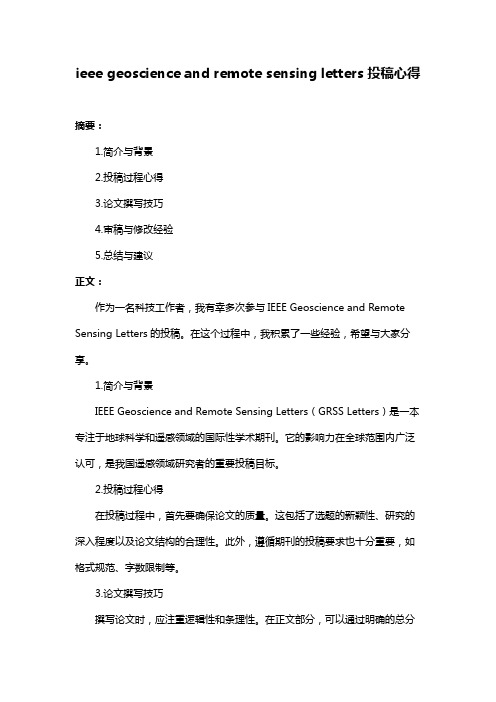
ieee geoscience and remote sensing letters投稿心得摘要:1.简介与背景2.投稿过程心得3.论文撰写技巧4.审稿与修改经验5.总结与建议正文:作为一名科技工作者,我有幸多次参与IEEE Geoscience and Remote Sensing Letters的投稿。
在这个过程中,我积累了一些经验,希望与大家分享。
1.简介与背景IEEE Geoscience and Remote Sensing Letters(GRSS Letters)是一本专注于地球科学和遥感领域的国际性学术期刊。
它的影响力在全球范围内广泛认可,是我国遥感领域研究者的重要投稿目标。
2.投稿过程心得在投稿过程中,首先要确保论文的质量。
这包括了选题的新颖性、研究的深入程度以及论文结构的合理性。
此外,遵循期刊的投稿要求也十分重要,如格式规范、字数限制等。
3.论文撰写技巧撰写论文时,应注重逻辑性和条理性。
在正文部分,可以通过明确的总分总结构来组织内容。
同时,注意使用恰当的术语和表达,以提高论文的可读性。
在引用文献时,要确保引用的文献与研究主题密切相关,且遵循期刊的引用规范。
4.审稿与修改经验审稿过程中,可能会收到审稿人的意见。
对于这些意见,要认真对待,理性分析。
针对审稿人的疑问,要有针对性地进行解答和修改。
在修改论文时,不仅要关注内容的完善,还要注意格式的规范和语言的准确性。
5.总结与建议投稿IEEE Geoscience and Remote Sensing Letters是一个锻炼科研能力和写作水平的过程。
通过这次投稿经历,我认识到高质量的论文是基础,严谨的态度和合理的结构是关键。
同时,与审稿人的良好沟通和积极修改也是成功投稿的重要因素。
最后,建议大家在投稿前充分了解期刊的倾向和要求,有针对性地进行论文撰写。
在投稿过程中,保持耐心和毅力,不断学习和进步。
ieee transactions on signal processing 投稿经验分享
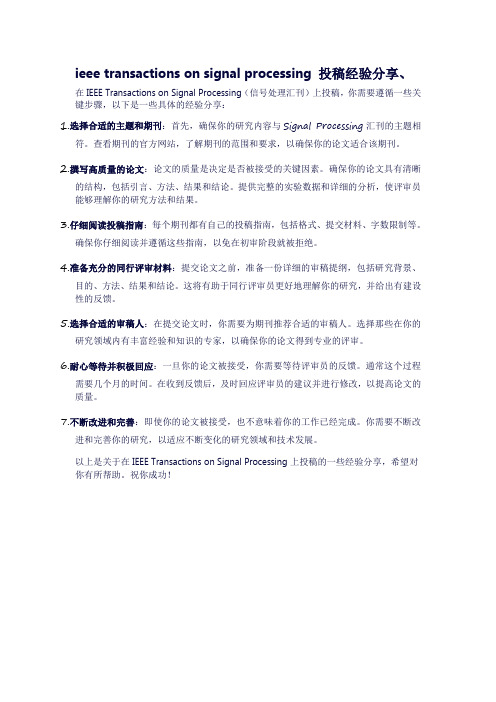
ieee transactions on signal processing 投稿经验分享、在IEEE Transactions on Signal Processing(信号处理汇刊)上投稿,你需要遵循一些关键步骤,以下是一些具体的经验分享:1.选择合适的主题和期刊:首先,确保你的研究内容与Signal Processing汇刊的主题相符。
查看期刊的官方网站,了解期刊的范围和要求,以确保你的论文适合该期刊。
2.撰写高质量的论文:论文的质量是决定是否被接受的关键因素。
确保你的论文具有清晰的结构,包括引言、方法、结果和结论。
提供完整的实验数据和详细的分析,使评审员能够理解你的研究方法和结果。
3.仔细阅读投稿指南:每个期刊都有自己的投稿指南,包括格式、提交材料、字数限制等。
确保你仔细阅读并遵循这些指南,以免在初审阶段就被拒绝。
4.准备充分的同行评审材料:提交论文之前,准备一份详细的审稿提纲,包括研究背景、目的、方法、结果和结论。
这将有助于同行评审员更好地理解你的研究,并给出有建设性的反馈。
5.选择合适的审稿人:在提交论文时,你需要为期刊推荐合适的审稿人。
选择那些在你的研究领域内有丰富经验和知识的专家,以确保你的论文得到专业的评审。
6.耐心等待并积极回应:一旦你的论文被接受,你需要等待评审员的反馈。
通常这个过程需要几个月的时间。
在收到反馈后,及时回应评审员的建议并进行修改,以提高论文的质量。
7.不断改进和完善:即使你的论文被接受,也不意味着你的工作已经完成。
你需要不断改进和完善你的研究,以适应不断变化的研究领域和技术发展。
以上是关于在IEEE Transactions on Signal Processing上投稿的一些经验分享,希望对你有所帮助。
祝你成功!。
ieee transactions on industrial electronics 投稿经验
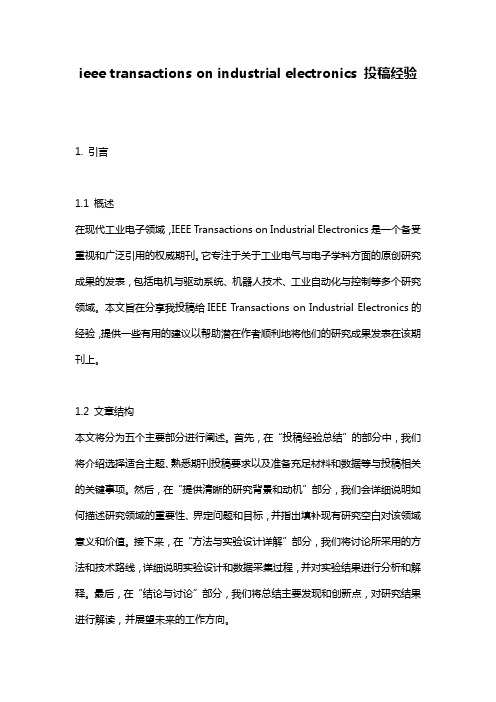
ieee transactions on industrial electronics 投稿经验1. 引言1.1 概述在现代工业电子领域,IEEE Transactions on Industrial Electronics是一个备受重视和广泛引用的权威期刊。
它专注于关于工业电气与电子学科方面的原创研究成果的发表,包括电机与驱动系统、机器人技术、工业自动化与控制等多个研究领域。
本文旨在分享我投稿给IEEE Transactions on Industrial Electronics的经验,提供一些有用的建议以帮助潜在作者顺利地将他们的研究成果发表在该期刊上。
1.2 文章结构本文将分为五个主要部分进行阐述。
首先,在“投稿经验总结”的部分中,我们将介绍选择适合主题、熟悉期刊投稿要求以及准备充足材料和数据等与投稿相关的关键事项。
然后,在“提供清晰的研究背景和动机”部分,我们会详细说明如何描述研究领域的重要性、界定问题和目标,并指出填补现有研究空白对该领域意义和价值。
接下来,在“方法与实验设计详解”部分,我们将讨论所采用的方法和技术路线,详细说明实验设计和数据采集过程,并对实验结果进行分析和解释。
最后,在“结论与讨论”部分,我们将总结主要发现和创新点,对研究结果进行解读,并展望未来的工作方向。
1.3 目的本文的目的是为那些有意向投稿给IEEE Transactions on Industrial Electronics的作者提供一些宝贵的经验和建议。
我们将通过分享我们在投稿过程中所收获到的教训和成功经验,帮助读者更好地理解并应用这些经验于他们自己的研究工作中。
通过遵循这些建议,潜在作者将能够增加他们研究成果被该期刊接受发表的机会,并提高文章质量以及学术影响力。
2. 投稿经验总结:2.1 选择适合的主题:在投稿IEEE Transactions on Industrial Electronics之前,首先要仔细选择一个与该期刊相关的主题。
ieeeaccess投稿经验
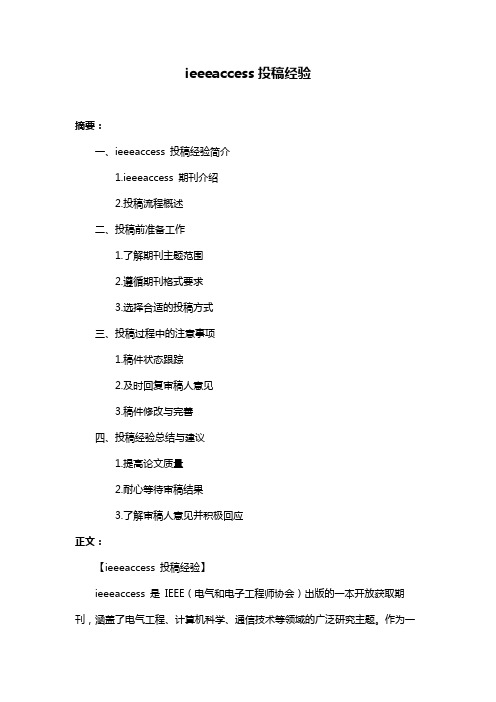
ieeeaccess投稿经验摘要:一、ieeeaccess 投稿经验简介1.ieeeaccess 期刊介绍2.投稿流程概述二、投稿前准备工作1.了解期刊主题范围2.遵循期刊格式要求3.选择合适的投稿方式三、投稿过程中的注意事项1.稿件状态跟踪2.及时回复审稿人意见3.稿件修改与完善四、投稿经验总结与建议1.提高论文质量2.耐心等待审稿结果3.了解审稿人意见并积极回应正文:【ieeeaccess 投稿经验】ieeeaccess 是IEEE(电气和电子工程师协会)出版的一本开放获取期刊,涵盖了电气工程、计算机科学、通信技术等领域的广泛研究主题。
作为一本高质量的科技期刊,ieeeaccess 在学术界享有较高的声誉。
本文将分享一些关于ieeeaccess 投稿的经验和建议,帮助您顺利投稿并提高稿件被接受的可能性。
在投稿前,了解ieeeaccess 期刊的主题范围和发表要求是非常重要的。
您可以在官方网站上查看期刊的详细信息,确保您的研究主题符合期刊的发表范畴。
此外,遵循期刊的格式要求也是必不可少的。
请务必仔细阅读官方网站提供的投稿指南,确保您的稿件符合期刊的格式要求。
在准备好稿件后,您可以选择合适的投稿方式,如通过在线系统或电子邮件进行投稿。
在投稿过程中,您需要密切关注稿件状态的变化。
通常情况下,稿件会经过编辑初审、匿名审稿等环节。
在投稿过程中,您可能会收到审稿人的意见和建议。
这时,您需要及时回复审稿人,表明您已经收到意见并着手进行修改。
在修改过程中,请务必认真对待审稿人的意见,尽可能地满足他们的要求。
同时,您还可以主动与编辑沟通,了解稿件的进展情况。
总之,在ieeeaccess 投稿过程中,提高论文质量是关键。
您需要确保您的研究内容具有创新性、实用性和严谨性。
此外,耐心等待审稿结果并了解审稿人意见也是非常重要的。
ieee geoscience and remote sensing letters 投稿经验
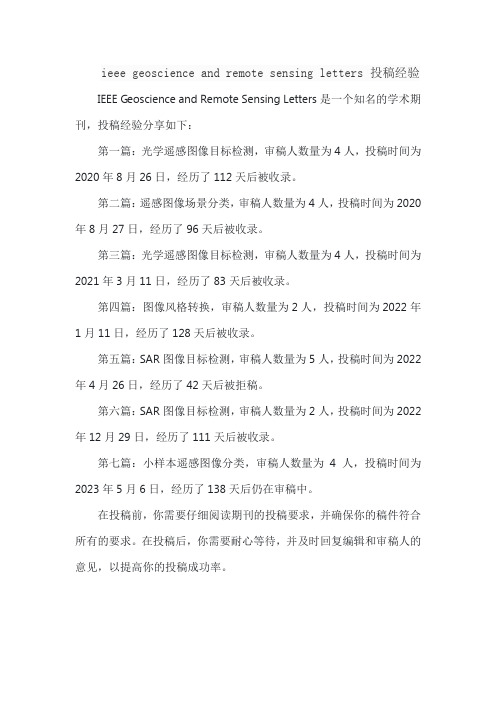
ieee geoscience and remote sensing letters 投稿经验IEEE Geoscience and Remote Sensing Letters是一个知名的学术期刊,投稿经验分享如下:
第一篇:光学遥感图像目标检测,审稿人数量为4人,投稿时间为2020年8月26日,经历了112天后被收录。
第二篇:遥感图像场景分类,审稿人数量为4人,投稿时间为2020年8月27日,经历了96天后被收录。
第三篇:光学遥感图像目标检测,审稿人数量为4人,投稿时间为2021年3月11日,经历了83天后被收录。
第四篇:图像风格转换,审稿人数量为2人,投稿时间为2022年1月11日,经历了128天后被收录。
第五篇:SAR图像目标检测,审稿人数量为5人,投稿时间为2022年4月26日,经历了42天后被拒稿。
第六篇:SAR图像目标检测,审稿人数量为2人,投稿时间为2022年12月29日,经历了111天后被收录。
第七篇:小样本遥感图像分类,审稿人数量为4人,投稿时间为2023年5月6日,经历了138天后仍在审稿中。
在投稿前,你需要仔细阅读期刊的投稿要求,并确保你的稿件符合所有的要求。
在投稿后,你需要耐心等待,并及时回复编辑和审稿人的意见,以提高你的投稿成功率。
IEEE投稿指南
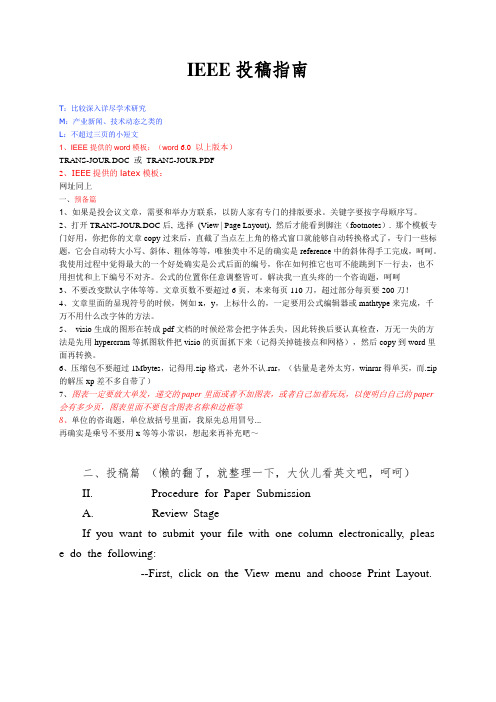
IEEE投稿指南T:比较深入详尽学术研究M:产业新闻、技术动态之类的L:不超过三页的小短文1、IEEE提供的word模板:(word 6.0 以上版本)TRANS-JOUR.DOC 或TRANS-JOUR.PDF2、IEEE提供的latex模板:网址同上一、预备篇1、如果是投会议文章,需要和举办方联系,以防人家有专门的排版要求。
关键字要按字母顺序写。
2、打开TRANS-JOUR.DOC后, 选择(View | Page Layout), 然后才能看到脚注(footnotes). 那个模板专门好用,你把你的文章copy过来后,直截了当点左上角的格式窗口就能够自动转换格式了,专门一些标题,它会自动转大小写、斜体、粗体等等,唯独美中不足的确实是reference中的斜体得手工完成,呵呵。
我使用过程中觉得最大的一个好处确实是公式后面的编号,你在如何推它也可不能跳到下一行去,也不用担忧和上下编号不对齐。
公式的位置你任意调整皆可。
解决我一直头疼的一个咨询题,呵呵3、不要改变默认字体等等。
文章页数不要超过6页,本来每页110刀,超过部分每页要200刀!4、文章里面的显现符号的时候,例如x,y,上标什么的,一定要用公式编辑器或mathtype来完成,千万不用什么改字体的方法。
5、visio生成的图形在转成pdf文档的时候经常会把字体丢失,因此转换后要认真检查,万无一失的方法是先用hypercram等抓图软件把visio的页面抓下来(记得关掉链接点和网格),然后copy到word里面再转换。
6、压缩包不要超过1Mbytes,记得用.zip格式,老外不认.rar,(估量是老外太穷,winrar得单买,而.zip 的解压xp差不多自带了)7、图表一定要放大单发,递交的paper里面或者不加图表,或者自己加着玩玩,以便明白自己的paper 会有多少页,图表里面不要包含图表名称和边框等8、单位的咨询题,单位放括号里面,我原先总用冒号...再确实是乘号不要用x等等小常识,想起来再补充吧~二、投稿篇(懒的翻了,就整理一下,大伙儿看英文吧,呵呵)II.Procedure for Paper SubmissionA.Review StageIf you want to submit your file with one column electronically, pleas e do the following:--First, click on the View menu and choose Print Layout.--Second, place your cursor in the first paragraph. Go to the Format menu, choose Columns, choose one column Layout, and choos e “apply to whole document”from the dropdown menu.--Third, click and drag the right margin bar to just over4 inches in width.The graphics will stay in the “second”column, but you can drag t hem to the first column. Make the graphic wider to push out any text th at may try to fill in next to the graphic.B.Final StageWhen you submit your final version, after your paper has been accep ted, print it in two-column format, including figures and tables. Send thre e prints of the paper; two will go to IEEE and one will be retained by t he Editor-in-Chief or conference publications chair.You must also send your final manuscript on a disk, which IEEE wil l use to prepare your paper for publication. Write the authors’names on the disk label. If you are using a Macintosh, please save your file on a PC formatted disk, if possible. You may use Zip or CD-ROM disks for l arge files, or compress files using Compress, Pkzip, Stuffit, or Gzip.C.Figures (这段专门重要,确实是讲图表一定要放大单发,递交的paper里面或者不加图表,或者自己加着玩玩,以便明白自己的pap er会有多少页)All tables and figures will be processed as images. However, IEEE c annot extract the tables and figures embedded in your document. (The fig ures and tables you insert in your document are only to help you gauge t he size of your paper, for the convenience of the referees, and to make it easy for you to distribute preprints.) Therefore, submit, on separate sheet s of paper, enlarged versions of the tables and figures that appear in your document. These are the images IEEE will scan and publish with your p aper.D.Electronic Image Files (Optional)You will have the greatest control over the appearance of your figure s if you are able to prepare electronic image files. If you do not have th e required computer skills, just submit paper prints as described above and skip this section.1) Easiest Way: If you have a scanner, the best and quickest way to prepare noncolor figure files is to print your tables and figures on paper exactly as you want them to appear, scan them, and then save them toa file in PostScript (PS) or Encapsulated PostScript (EPS) formats. Use a separate file for each image. File names should be of the form “fig1.ps”or “fig2.eps.”2) Slightly Harder Way: Using a scanner as above, save the images i n TIFF format. High-contrast line figures and tables should be prepared w ith 600 dpi resolution and saved with no compression, 1 bit per pixel (m onochrome), with file names of the form “fig3.tif”or “table1.tif.”To obtain a 3.45-in figure (one-column width) at 600 dpi, the figure requires a horizontal size of 2070 pixels. Typical file sizes will be on the order of 0.5 MB.Photographs and grayscale figures should be prepared with 220 dpi r esolution and saved with no compression, 8 bits per pixel (grayscale). To obtain a 3.45-in figure (one-column width) at 220 dpi, the figure should have a horizontal size of 759 pixels.Color figures should be prepared with 400 dpi resolution and saved with no compression, 8 bits per pixel (palette or 256 color). To obtain a 3.45-in figure (one column width) at 400 dpi, the figure should have a h orizontal size of 1380 pixels.4) Other Ways: Experienced computer users can convert figures and t ables from their original format to TIFF. Some useful image converters ar e Adobe Photoshop, Corel Draw, and Microsoft Photo Editor, an application that is part of Microsoft Office 97 and Office 2000 (look for C:\Progr am Files\Common Files \Microsoft Shared\ PhotoEd\ PHOTOED.EXE. (Yo u may have to custom-install Photo Editor from your original Office dis k.)Here is a way to make TIFF image files of tables. First, create your table in Word. Use horizontal lines but no vertical lines. Hide gridlines (Table | Hide Gridlines). Spell check the table to remove any red underlin es that indicate spelling errors. Adjust magnification (View | Zoom) such that you can view the entire table at maximum area when you select Vie w | Full Screen. Move the cursor so that it is out of the way. Press “Pr int Screen”on your keyboard; this copies the screen image to the Windo ws clipboard. Open Microsoft Photo Editor and click Edit | Paste as New Image. Crop the table image (click Select button; select the part you wa nt, then Image | Crop). Adjust the properties of the image (File | Properti es) to monochrome (1 bit) and 600 pixels per inch. Resize the image (Im age | Resize) to a width of 3.45 inches. Save the file (File | Save As) in TIFF with no compression (click “More”button).Most graphing programs allow you to save graphs in TIFF; however, you often have no control over compression or number of bits per pixel. You should open these image files in a program such as Microsoft Phot o Editor and re-save them using no compression, either 1 or 8 bits, and either 600 or 220 dpi resolution (File | Properties; Image | Resize). See S ection II-D2 for an explanation of number of bits and resolution. If your graphing program cannot export to TIFF, you can use the same technique described for tables in the previous paragraph.A way to convert a figure from Windows Metafile (WMF) to TIFF i s to paste it into Microsoft PowerPoint, save it in JPG format, open it wi th Microsoft Photo Editor or similar converter, and re-save it as TIFF.Microsoft Excel allows you to save spreadsheet charts in Graphics In terchange Format (GIF). To get good resolution, make the Excel charts ve ry large. Then use the “Save asNo matter how you convert your images, it is a good idea to print t he TIFF files to make sure nothing was lost in the conversion.If you modify this document for use with other IEEE journals or co nferences, you should save it as type “Word 97-2000 & 6.0/95 - RTF (*. doc)”so that it can be opened by any version of Word.E.Copyright FormIII.MATHIV.UnitsUse either SI (MKS) or CGS as primary units. (SI units are strongly encouraged.) English units may be used as secondary units (in parenthes es). This applies to papers in data storage. For example, write “15 Gb/c m2 (100 Gb/in2).”An exception is when English units are used as ident ifiers in trade, such as “3½in disk drive.”Avoid combining SI and C GS units, such as current in amperes and magnetic field in oersteds. This often leads to confusion because equations do not balance dimensionally. If you must use mixed units, clearly state the units for each quantity in an equation.The SI unit for magnetic field strength H is A/m. However, if you wish to use units of T, either refer to magnetic flux density B or magneti c field strength symbolized as µ0H. Use the center dot to separate comp ound units, e.g., “A·m2.”V.Helpful HintsA.Figures and TablesBecause IEEE will do the final formatting of your paper, you do not need to position figures and tables at the top and bottom of each colum n. In fact, all figures, figure captions, and tables can be at the end of thepaper. Large figures and tables may span both columns. Place figure cap tions below the figures; place table titles above the tables. If your figure has two parts, include the labels “(a)”and “(b)”as part of the artwo rk. Please verify that the figures and tables you mention in the text actua lly exist. Please do not include captions as part of the figures. Do not pu t captions in “text boxes”linked to the figures. Do not put borders aro und the outside of your figures. Use the abbreviation “Fig.”even at the beginning of a sentence. Do not abbreviate “Table.”Tables are number ed with Roman numerals.Figure axis labels are often a source of confusion. Use words rather than symbols. As an example, write the quantity “Magnetization,”or “M agnetization M,”not just “M.”Put units in parentheses. Do not label axes only with units. As in Fig. 1, for example, write “Magnetization (A /m)”or “Magnetization (A m-1),”not just “A/m.”Do not label axe s with a ratio of quantities and units. For example, write “Temperature (K),”not “Temperature/K.”B.ReferencesPlease note that the references at the end of this document are in th e preferred referencing style. Give all authors’names; do not use “et al.”unless there are six authors or more. Use a space after authors' initials. Papers that have not been published should be cited as “unpublished”[4]. Papers that have been submitted for publication should be cited as “sub mitted for publication”[5]. Papers that have been accepted for publicatio n, but not yet specified for an issue should be cited as “to be published”[6]. Please give affiliations and addresses for private communications [7].Capitalize only the first word in a paper title, except for proper noun s and element symbols. For papers published in translation journals, pleas e give the English citation first, followed by the original foreign-language citation [8].C.Abbreviations and AcronymsDefine abbreviations and acronyms the first time they are used in the text, even after they have already been defined in the abstract. Abbreviat ions such as IEEE, SI, ac, and dc do not have to be defined. Abbreviatio ns that incorporate periods should not have spaces: write “C.N.R.S.,”no t “C. N. R. S.”Do not use abbreviations in the title unless they are un avoidable (for example, “IEEE”in the title of this article).D.EquationsNumber equations consecutively with equation numbers in parentheses flush with the right margin, as in (1). First use the equation editor to cr eate the equation. Then select the “Equation”markup style. Press the ta b key and write the equation number in parentheses. To make your equati ons more compact, you may use the solidus ( / ), the exp function, or a ppropriate exponents. Use parentheses to avoid ambiguities in denominator s. Punctuate equations when they are part of a sentence, as in(1)E.Other RecommendationsUse one space after periods and colons. Hyphenate complex modifier s: “zero-field-cooled magnetization.”Avoid dangling participles, such as, “Using (1), the potential was calculated.”[It is not clear who or what used (1).] Write instead, “The potential was calculated by using (1),”or “Using (1), we calculated the potential.”Use a zero before decimal points: “0.25,”not “.25.”Use “cm3,”not “cc.”Indicate sample dimensions as “0.1 cm ´0.2 cm,”not “0.1 ´0.2 cm2.”The abbreviation for “seconds”is “s,”not “se c.”Do not mix complete spellings and abbreviations of units: use “Wb/ m2”or “webers per square meter,”not “webers/m2.”When expressi ng a range of values, write “7 to 9”or “7-9,”not “7~9.”A parenthetical statement at the end of a sentence is punctuated outsi de of the closing parenthesis (like this). (A parenthetical sentence is punct uated within the parentheses.) In American English, periods and commas are within quotation marks, like “this period.”Other punctuation is “o utside”! Avoid contractions; for example, write “do not”instead of “d on’t.”The serial comma is preferred: “A, B, and C”instead of “A,B and C.”If you wish, you may write in the first person singular or plural and use the active voice (“I observed that ...”or “We observed that ...”instead of “It was observed that ...”). Remember to check spelling. If y our native language is not English, please get a native English-speaking c olleague to proofread your paper.VI.Some Common MistakesBe aware of the different meanings of the homophones “affect”(us ually a verb) and “effect”(usually a noun), “complement”and “com pliment,”“discreet”and “discrete,”“principal”(e.g., “principal i nvestigator”) and “principle”(e.g., “principle of measurement”). Do not confuse “imply”and “infer.”Prefixes such as “non,”“sub,”“micro,”“multi,”and “"ultr a”are not independent words; they should be joined to the words they modify, usually without a hyphen. There is no period after the “et”in t he Latin abbreviation “et al.”(it is also italicized). The abbreviation “i.e.,”means “that is,”and the abbreviation “e.g.,”means “for examp le”(these abbreviations are not italicized).An excellent style manual and source of information for science writ ers is [9]. A general IEEE style guide, Information for Authors, is availab le at。
{选}IEEE投稿指南 ln
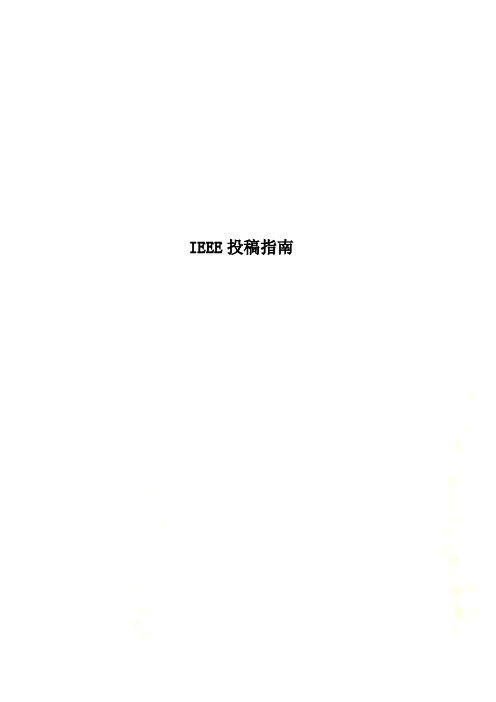
IEEE投稿指南IEEE journal 投稿指南T:比较深入详尽学术研究M:产业新闻、技术动态之类的L:不超过三页的小短文1、IEEE提供的word模板:(word 6.0 以上版本)TRANS-JOUR.DOC 或TRANS-JOUR.PDF/organizations/pubs/transactions/stylesheets.htm2、IEEE提供的latex模板:网址同上一、准备篇1、如果是投会议文章,需要和举办方联系,以防人家有特殊的排版要求。
关键字要按字母顺序写。
参考/organizations/pubs/ani_prod/keywrd98.txt2、打开TRANS-JOUR.DOC后, 选择(View | Page Layout), 然后才能看到脚注(footnotes). 这个模板很好用,你把你的文章copy过来后,直接点左上角的格式窗口就可以自动转换格式了,尤其一些标题,它会自动转大小写、斜体、粗体等等,唯一美中不足的就是reference中的斜体得手工完成,呵呵。
我使用过程中觉得最大的一个好处就是公式后面的编号,你在怎么推它也不会跳到下一行去,也不用担心和上下编号不对齐。
公式的位置你任意调整皆可。
解决我一直头疼的一个问题,呵呵3、不要改变默认字体等等。
文章页数不要超过6页,本来每页110刀,超过部分每页要200刀!4、文章里面的出现符号的时候,比如x,y,上标什么的,一定要用公式编辑器或mathtype来完成,千万别用什么改字体的方法。
5、visio生成的图形在转成pdf文档的时候经常会把字体丢失,所以转换后要仔细检查,万无一失的方法是先用hypercram等抓图软件把visio的页面抓下来(记得关掉链接点和网格),然后copy到word里面再转换。
6、压缩包不要超过1Mbytes,记得用.zip格式,老外不认.rar,(估计是老外太穷,winrar得单买,而.zip 的解压xp已经自带了)7、图表一定要放大单发,递交的paper里面或者不加图表,或者自己加着玩玩,以便知道自己的paper会有多少页,图表里面不要包含图表名称和边框等8、单位的问题,单位放括号里面,我原来总用冒号...再就是乘号不要用x等等小常识,想起来再补充吧~二、投稿篇(懒的翻了,就整理一下,大家看英文吧,呵呵)II.Procedure for Paper SubmissionA.Review StagePlease check with your editor on whether to submit your manuscript by hard copy or electronically for review. If hard copy, submit photocopies such that only one column appears per page. This will give your referees plenty of room to write comments. Send the number of copies specified by your editor (typically four). If submitted electronically, find out if your editor prefers submissions on disk or as e-mail attachments.If you want to submit your file with one column electronically, please do the following:--First, click on the View menu and choose Print Layout.--Second, place your cursor in the first paragraph. Go to the Format menu, choose Columns, choose one column Layout, and choos e “apply to whole document” from the dropdown menu.--Third, click and drag the right margin bar to just over 4 inches in width.The graphics will stay in the “second” column, but you can drag them to the first column. Make the graphic wider to push out any text that may try to fill in next to the graphic.B.Final StageWhen you submit your final version, after your paper has been accepted, print it in two-column format, including figures and tables. Send three prints of the paper; two will go to IEEE and one will be retained by the Editor-in-Chief or conference publications chair.You must also send your final manuscript on a disk, which IEEE will use to prepare your paper for publication. Write the authors’ names on the disk label. If you are us ing a Macintosh, please save your file on a PC formatted disk, if possible. You may use Zip or CD-ROM disks for large files, or compress files using Compress, Pkzip, Stuffit, or Gzip.Also send a sheet of paper with complete contact information for all authors. Include full mailing addresses, telephone numbers, fax numbers, and e-mail addresses. This information will be used to send each author a complimentary copy of the journal in which the paper appears. In addition, designate one author as the “corresponding author.” This is the author to whom proofs of the paper will be sent. Proofs are sent to the corresponding author only.C.Figures (这段很重要,就是说图表一定要放大单发,递交的paper里面或者不加图表,或者自己加着玩玩,以便知道自己的paper会有多少页)All tables and figures will be processed as images. However, IEEE cannot extract the tables and figures embedded in your document. (The figures and tables you insert in your document are only to help you gauge the size of your paper, for the convenience of the referees, and to make it easy for you to distribute preprints.) Therefore, submit, on separate sheets of paper, enlarged versions of the tables and figures that appear in your document. These are the images IEEE will scan and publish with your paper.D.Electronic Image Files (Optional)You will have the greatest control over the appearance of your figures if you are able to prepare electronic image files. If you do not have the required computer skills, just submit paper prints as described above and skip this section.1) Easiest Way: If you have a scanner, the best and quickest way to prepare noncolor figure files is to print your tables and figures on paper exactly as you want them to appear, scan them, and then save them to a file in PostScript (PS) or Encapsulated PostScript (EPS) formats. Use a separate file for each image. File names should be of the form “fig1.ps” or “fig2.eps.”2) Slightly Harder Way: Using a scanner as above, save the images in TIFF format. High-contrast line figures and tables should be prepared with 600 dpi resolution and saved with no compression,1 bit per pixel (monochrome), with file names of the form “fig3.tif” or “table1.tif.” To obtain a 3.45-in figure (one-column width) at 600 dpi, the figure requires a horizontal size of 2070 pixels. Typical file sizes will be on the order of 0.5 MB.Photographs and grayscale figures should be prepared with 220 dpi resolution and saved with no compression, 8 bits per pixel (grayscale). To obtain a 3.45-in figure (one-column width) at 220 dpi, the figure should have a horizontal size of 759 pixels.Color figures should be prepared with 400 dpi resolution and saved with no compression, 8 bits per pixel (palette or 256 color). To obtain a 3.45-in figure (one column width) at 400 dpi, the figure should have a horizontal size of 1380 pixels.For more information on TIFF files, please go to /organizations/pubs/transactions/information.htm and click on the link “Guidelines for Author Supplied Electronic Text and Graphics.”3) Somewhat Harder Way:If you do not have a scanner, you may create noncolor PostScript figures by “printing” them to files. First, download a PostScript printer driver from /support/downloads/pdrvwin.htm(for Windows) or from /support/downloads/ pdrvmac.htm(for Macintosh) and install the “Generic PostScript Printer” definition. In Word, paste your figure into a new document. Print to a file using the PostScript printer driver. File names should be of the form “fig5.ps.” Use Adobe Type 1 fonts when creating your figures, if possible.4) Other Ways:Experienced computer users can convert figures and tables from their original format to TIFF. Some useful image converters are Adobe Photoshop, Corel Draw, and Microsoft Photo Editor,an application that is part of Microsoft Office 97and Office 2000(look for C:\Program Files\Common Files \Microsoft Shared\ PhotoEd\ PHOTOED.EXE. (You may have to custom-install Photo Editor from your original Office disk.)Here is a way to make TIFF image files of tables. First, create your table in Word. Use horizontal lines but no vertical lines. Hide gridlines (Table | Hide Gridlines). Spell check the table to remove any red underlines that indicate spelling errors. Adjust magnification (View | Zoom) such that you can view the entire table at maximum area when you select View | Full Screen. Move the cursor so that it is out of the way. Press “Print Screen” on your keyboard; this copies the screen image to the Windows clipboard. Open Microsoft Photo Editor and click Edit | Paste as New Image. Crop the table image (click Select button; select the part you want, then Image | Crop). Adjust the properties of the image (File | Properties) to monochrome (1 bit) and 600 pixels per inch. Resize the image (Image | Resize) to a width of 3.45 inches. Save the file (File | Save As) in TIFF with no compression (click “More” button).Most graphing programs allow you to save graphs in TIFF; however, you often have no control over compression or number of bits per pixel. You should open these image files in a program such as Microsoft Photo Editor and re-save them using no compression, either 1 or 8 bits, and either 600 or 220 dpi resolution (File | Properties; Image | Resize). See Section II-D2 for an explanation of number of bits and resolution. If your graphing program cannot export to TIFF, you can use the same technique described for tables in the previous paragraph.A way to convert a figure from Windows Metafile (WMF) to TIFF is to paste it into Microsoft PowerPoint, save it in JPG format, open it with Microsoft Photo Editor or similar converter, and re-save it as TIFF.Microsoft Excel allows you to save spreadsheet charts in Graphics Interchange Format (GIF). To get good resolution, make the Excel charts very large. Then use the “Save asHTML” feature (see /support/ kb/articles/q158/0/79.asp). You can then convert from GIF to TIFF using Microsoft Photo Editor, for example.No matter how you convert your images, it is a good idea to print the TIFF files to make sure nothing was lost in the conversion.If you modify this document for use with other IEEE journals or conferences, you should save it as type “Word 97-2000 & 6.0/95 - RTF (*.doc)” so that it can be opened by any version of Word.E.Copyright FormAn IEEE copyright form should accompany your final submission. You can get a .pdf, .html, or .doc version at /copyright or from the first issues in each volume of the IEEE T RANSACTIONS and J OURNALS.Authors are responsible for obtaining any security clearances.III.M ATHIf you are using Word, use either the Microsoft Equation Editor or the MathType add-on () for equations in your paper (Insert | Object | Create New | Microsoft Equation or MathType Equation). “Float over text” should not be selected.IV.UnitsUse either SI (MKS) or CGS as primary units. (SI units are strongly encouraged.) English units may be used as secondary units (in parentheses). This applies to papers in data storage. For example, write “15 Gb/cm2 (100 Gb/in2).” An exception is when English units are used as identifiers in trade, such as “3½ in disk drive.” Avoid combining SI and CGS units, such as current in amperes and magnetic field in oersteds. This often leads to confusion because equations do not balance dimensionally. If you must use mixed units, clearly state the units for each quantity in an equation.The SI unit for magnetic field strength H is A/m. However, if you wish to use units of T, either refer to magnetic flux density B or magnetic field strength symbolized as µ0H. Use the center dot to separate compound units, e.g., “A·m2.”V.Helpful HintsA.Figures and TablesBecause IEEE will do the final formatting of your paper, you do not need to position figures and tables at the top and bottom of each column. In fact, all figures, figure captions, and tables can be at the end of the paper. Large figures and tables may span both columns. Place figure captions below the figures; place table titles above the tables. If your figure has two parts, include the labels “(a)” and “(b)” as part of the artwork. Please verify that the figures and tables you mention in the text actually exist. Please do not include captions as part of the figures. Do not put captions in “text boxes” linked to the figures. Do not put borders around the outside of your figures. Use the abbreviation “Fig.” even at the beginning of a sentence. Do not abbreviate “Table.” Tables are numbered with Roman numeral s.Color printing of figures is available, but is billed to the authors (approximately $1300, depending on the number of figures and number of pages containing color). Include a note with your final paper indicating that you request color printing. Do not use color unless it is necessary for the proper interpretation of your figures. If you want reprints of your color article, the reprint order should be submitted promptly. There is an additional charge of $81 per 100 for color reprints.Figure axis labels are often a source of confusion. Use words rather than symbols. As an example, write the quantity “Magnetization,” or “Magnetization M,” not just “M.” Put units in parentheses. Do not label axes only with units. As in Fig. 1, for example, write “Magnetiza tion (A/m)” or “Magnetization (A m-1),” not just “A/m.” Do not label axes with a ratio of quantities and units. For example, write “Temperature (K),” not “Temperature/K.”Multipliers can be especially confusing. Write “Magnetization (kA/m)” or “Magnetizat ion (103A/m).” Do not write “Magnetization (A/m) ´1000” because the reader would not know whether the top axis label in Fig. 1 meant 16000 A/m or 0.016 A/m. Figure labels should be legible, approximately 8 to 12 point type.B.ReferencesNumber citations consecutively in square brackets [1]. The sentence punctuation follows the brackets [2]. Multiple references [2], [3] are each numbered with separate brackets [1]–[3]. When citing a section in a book, please give the relevant page numbers [2]. In sentences, refer simply to the reference number, as in [3]. Do not use “Ref. [3]” or “reference [3]” except at the beginning of a sentence: “Reference [3] shows ... .” Unfortunately the IEEE document translator cannot handle automatic endnotes in Word; therefore, type the reference list at the end of the paper using the “References” style.Number footnotes separately in superscripts (Insert | Footnote).[1] Place the actual footnote at the bottom of the column in which it is cited; do not put footnotes in the reference list (endnotes). Use letters for table footnotes (see Table I).Please note that the references at the end of this document are in the preferred referencing style. Give all authors’ names; do not use “et al.” unless there are six authors or more. Use a space after authors' initials. Papers that have not been published should be cited as “unpublished” [4]. Papers that have been submitted for publication should be cited as “submitted for publication”[5]. Papers that have been accepted for publication, but not yet specified for an issue should be cited as “to be published” [6]. Please give affiliations and addresses for private communications [7].Capitalize only the first word in a paper title, except for proper nouns and element symbols. For papers published in translation journals, please give the English citation first, followed by the original foreign-language citation [8].C.Abbreviations and AcronymsDefine abbreviations and acronyms the first time they are used in the text, even after they have already been defined in the abstract. Abbreviations such as IEEE, SI, ac, and dc do not have to be defined. Abbreviations that incorporate periods should not have spaces: writ e “C.N.R.S.,” not “C. N. R. S.” Do not use abbreviations in the title unless they are unavoidable (for example, “IEEE” in the title of this article).D.EquationsNumber equations consecutively with equation numbers in parentheses flush with the right margin, as in (1). First use the equation editor to create the equation. Then select the “Equation” markup style. Press the tab key and write the equation number in parentheses. To make your equations more compact, you may use the solidus ( / ), the exp function, or appropriate exponents. Use parentheses to avoid ambiguities in denominators. Punctuate equations when they are partof a sentence, as in(1)Be sure that the symbols in your equation have been defined before the equation appears or immediately following. Italicize symbols (T might refer to temperature, but T is the unit tesla). Refer to “(1),” not “Eq. (1)” or “equation (1),” except at the beginning of a sentence: “Equation (1) is ... .”E.Other RecommendationsUse one space after per iods and colons. Hyphenate complex modifiers: “zero-field-cooled magnetization.” Avoid dangling participles, such as, “Using (1), the potential was calculated.” [It is not clear who or what used (1).] Write instead, “The potential was calculated by using (1),” or “Using (1), we calculated the potential.”Use a zero before decimal points: “0.25,” not “.25.” Use “cm3,” not “cc.” Indicate sample dimensions as “0.1 cm ´0.2 cm,” not “0.1 ´ 0.2 cm2.” The abbreviation for “seconds” is “s,” not “sec.” Do not mix complete spellings and abbreviations of units: use “Wb/m2” or “webers per square meter,” not “webers/m2.” When expressing a range of values, write “7 to 9” or “7-9,” not “7~9.”A parenthetical statement at the end of a sentence is punctuated outside of the closing parenthesis (like this). (A parenthetical sentence is punctuated within the parentheses.) In American English, periods and commas are within quotation marks, like “this period.” Other punctuation is “outside”! Avoid contractions; for example, write“do not” instead of “don’t.” The serial comma is preferred: “A, B, and C” instead of “A,B and C.”If you wish, you may write in the first person singular or plural and use the active voice (“I observed that ...” or “We observed that ...” instead of “It was observed that ...”). Remember to check spelling. If your native language is not English, please get a native English-speaking colleague to proofread your paper.VI.Some Common MistakesThe word “data” is plural, not singular. The subscript for the permeability of vacuum µ0 is zero, not a lowercase letter “o.” The term for residual magnetization is “remanence”; the adjective is “remanent”; do not write “remnance” or “remnant.” Use the word “micrometer” instead of “micron.” A graph within a graph is an “inset,” not an “insert.” The word “alternatively” is preferred to the word “alternately” (unless you really mean something that alternates). Use the word “whereas” instead of “while” (unless you are referring to simultaneous events). Do not use the wor d “essentially” to mean “approximately” or “effectively.” Do not use the word “issue” as a euphemism for “problem.” When compositions are not specified, separate chemical symbols by en-dashes; for example, “NiMn” indicates the intermetallic compound Ni0.5Mn0.5 whereas“Ni–Mn” indicates an alloy of some composition Ni x Mn1-x.Be aware of the different meanings of the homophones “affect” (usually a verb) and “effect” (usually a noun), “complement” and “compliment,” “discreet” and “discrete,” “principal” (e.g.,“principal investigator”) and “principle” (e.g., “principle of measurement”). Do not confuse “imply” and “infer.”Prefixes such as “non,” “sub,” “micro,” “multi,” and “"ultra” are not independent words; they should be joined to the words they modify, usually without a hyphen. There is no period after the “et” in the Latin abbreviation “et al.” (it is also italicized). The abbreviation “i.e.,” means “that is,” and the abbreviation “e.g.,” means “for example” (these abbreviations are not italicized).An excellent style manual and source of information for science writers is [9]. A general IEEE style guide, Information for Authors, is available at。
ieee transactions on energy conversion投稿经历
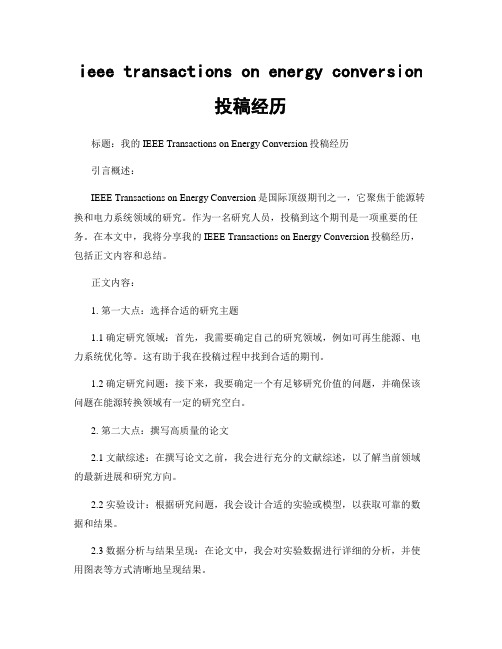
ieee transactions on energy conversion投稿经历标题:我的IEEE Transactions on Energy Conversion投稿经历引言概述:IEEE Transactions on Energy Conversion是国际顶级期刊之一,它聚焦于能源转换和电力系统领域的研究。
作为一名研究人员,投稿到这个期刊是一项重要的任务。
在本文中,我将分享我的IEEE Transactions on Energy Conversion投稿经历,包括正文内容和总结。
正文内容:1. 第一大点:选择合适的研究主题1.1 确定研究领域:首先,我需要确定自己的研究领域,例如可再生能源、电力系统优化等。
这有助于我在投稿过程中找到合适的期刊。
1.2 确定研究问题:接下来,我要确定一个有足够研究价值的问题,并确保该问题在能源转换领域有一定的研究空白。
2. 第二大点:撰写高质量的论文2.1 文献综述:在撰写论文之前,我会进行充分的文献综述,以了解当前领域的最新进展和研究方向。
2.2 实验设计:根据研究问题,我会设计合适的实验或模型,以获取可靠的数据和结果。
2.3 数据分析与结果呈现:在论文中,我会对实验数据进行详细的分析,并使用图表等方式清晰地呈现结果。
3. 第三大点:撰写投稿材料3.1 摘要和关键词:摘要应准确概括论文的研究目的、方法和结果,关键词应涵盖论文的核心内容。
3.2 引言:引言部分应简明扼要地介绍研究背景、研究问题和研究意义。
3.3 方法和实验:在这一部分,我会详细描述研究方法和实验设计,确保读者能够复现我的研究。
3.4 结果与讨论:我会清晰地呈现实验结果,并对结果进行深入的解读和讨论,将其与现有研究进行对比和分析。
3.5 结论:在结论中,我会总结研究的主要发现,并对未来研究方向提出建议。
4. 第四大点:投稿过程4.1 选择合适的期刊:根据我的研究主题和论文质量,我会选择合适的期刊投稿。
ieeeaccess投稿经验

ieeeaccess投稿经验IEEEAccess是一个国际知名的期刊,专注于发表电气与电子工程领域的学术论文。
该期刊致力于推动该领域的技术进步,为研究者提供一个分享研究成果、交流经验的平台。
本文将分享一些IEEEAccess 的投稿经验,帮助您更好地准备和完成投稿过程。
一、了解期刊要求在提交论文之前,您需要仔细阅读IEEEAccess的投稿须知,了解期刊的格式要求、论文范围、评审流程等。
确保您的论文符合期刊的要求,这将有助于提高您的稿件被接受的机率。
二、撰写高质量论文1.清晰简洁:确保论文结构清晰、逻辑严谨,避免使用过于专业的术语和复杂的公式推导,让读者能够快速理解您的研究内容。
2.突出创新点:在摘要和引言部分明确阐述您的研究贡献和创新点,吸引评审的关注。
3.充分实验支持:提供足够的实验数据和结果,支持您的论点。
确保图表和数据清晰易读,避免使用过多的文字描述。
4.总结与展望:在结论部分,对您的研究进行总结并展望未来可能的扩展和改进。
三、准备投稿材料1.确认论文格式:按照IEEEAccess的投稿须知,准备论文的排版和格式。
确保您的论文符合期刊的要求。
2.准备文档:将您的论文和其他相关材料(如作者声明、引用格式等)打包成一个压缩文件进行投稿。
3.确认作者信息:确保所有作者的信息准确无误,并按照要求填写作者声明和利益冲突声明。
四、耐心等待回复稿件评审周期通常较长,您需要耐心等待期刊的回复。
如果您收到初步审稿意见,需要及时修改和完善稿件,以便提高被接受的可能性。
五、认真对待审稿意见如果您收到了审稿意见,需要认真对待并逐一回复。
根据审稿人的建议修改您的论文,确保修改后的稿件质量得到提升。
六、接受或拒绝,保持专业与礼貌如果您的稿件被接受,恭喜您成功发表在IEEEAccess!如果被拒绝,也请保持专业与礼貌,接受评审人的建议并继续努力。
总之,要成功发表在IEEEAccess这样的知名期刊上,需要认真撰写高质量论文、了解期刊要求、准备投稿材料、耐心等待回复、认真对待审稿意见以及保持专业与礼貌。
投稿成功经验介绍
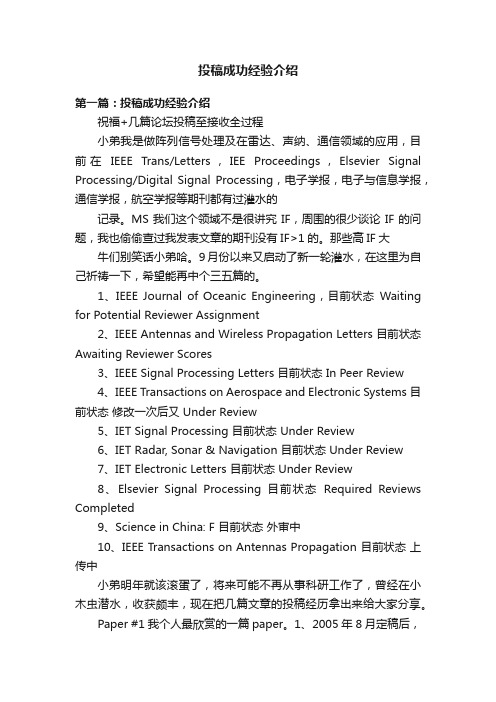
投稿成功经验介绍第一篇:投稿成功经验介绍祝福+几篇论坛投稿至接收全过程小弟我是做阵列信号处理及在雷达、声纳、通信领域的应用,目前在IEEE Trans/Letters,IEE Proceedings,Elsevier Signal Processing/Digital Signal Processing,电子学报,电子与信息学报,通信学报,航空学报等期刊都有过灌水的记录。
MS我们这个领域不是很讲究IF,周围的很少谈论IF的问题,我也偷偷查过我发表文章的期刊没有IF>1的。
那些高IF大牛们别笑话小弟哈。
9月份以来又启动了新一轮灌水,在这里为自己祈祷一下,希望能再中个三五篇的。
1、IEEE Journal of Oceanic Engineering,目前状态Waiting for Potential Reviewer Assignment2、IEEE Antennas and Wireless Propagation Letters 目前状态Awaiting Reviewer Scores3、IEEE Signal Processing Letters 目前状态 In Peer Review4、IEEE Transactions on Aerospace and Electronic Systems 目前状态修改一次后又 Under Review5、IET Signal Processing 目前状态 Under Review6、IET Radar, Sonar & Navigation 目前状态 Under Review7、IET Electronic Letters 目前状态 Under Review8、Elsevier Signal Processing 目前状态Required Reviews Completed9、Science in China: F 目前状态外审中10、IEEE Transactions on Antennas Propagation 目前状态上传中小弟明年就该滚蛋了,将来可能不再从事科研工作了,曾经在小木虫潜水,收获颇丰,现在把几篇文章的投稿经历拿出来给大家分享。
IET Communications投稿经验
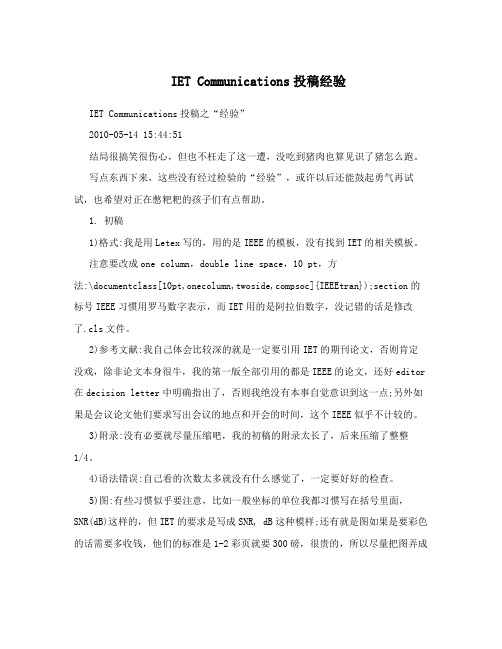
IET Communications投稿经验IET Communications投稿之“经验”2010-05-14 15:44:51结局很搞笑很伤心,但也不枉走了这一遭,没吃到猪肉也算见识了猪怎么跑。
写点东西下来,这些没有经过检验的“经验”,或许以后还能鼓起勇气再试试,也希望对正在憋粑粑的孩子们有点帮助。
1. 初稿1)格式:我是用Letex写的,用的是IEEE的模板,没有找到IET的相关模板。
注意要改成one column,double line space,10 pt,方法:\documentclass[10pt,onecolumn,twoside,compsoc]{IEEEtran});section的标号IEEE习惯用罗马数字表示,而IET用的是阿拉伯数字,没记错的话是修改了.cls文件。
2)参考文献:我自己体会比较深的就是一定要引用IET的期刊论文,否则肯定没戏,除非论文本身很牛,我的第一版全部引用的都是IEEE的论文,还好editor 在decision letter中明确指出了,否则我绝没有本事自觉意识到这一点;另外如果是会议论文他们要求写出会议的地点和开会的时间,这个IEEE似乎不计较的。
3)附录:没有必要就尽量压缩吧,我的初稿的附录太长了,后来压缩了整整1/4。
4)语法错误:自己看的次数太多就没有什么感觉了,一定要好好的检查。
5)图:有些习惯似乎要注意,比如一般坐标的单位我都习惯写在括号里面,SNR(dB)这样的,但IET的要求是写成SNR, dB这种模样;还有就是图如果是要彩色的话需要多收钱,他们的标准是1-2彩页就要300磅,很贵的,所以尽量把图弄成黑白就可以示意的,比如BER曲线用不同的圈圈点点区分不要只用曲线的颜色,不过初稿应该没事。
6)标题:尽然不让用a, the, new, novel之类的开头,这个比较奇怪。
7)公式:要求是适应双栏排版的,不过初稿没关系。
8)上传的文件:pdf或者doc,在以下网址提交,进入author center,按照提示操作9)审稿时间:我是1月初投的,4月13号给的结果,挺快的了。
ieee transactions on engineering management投稿经验
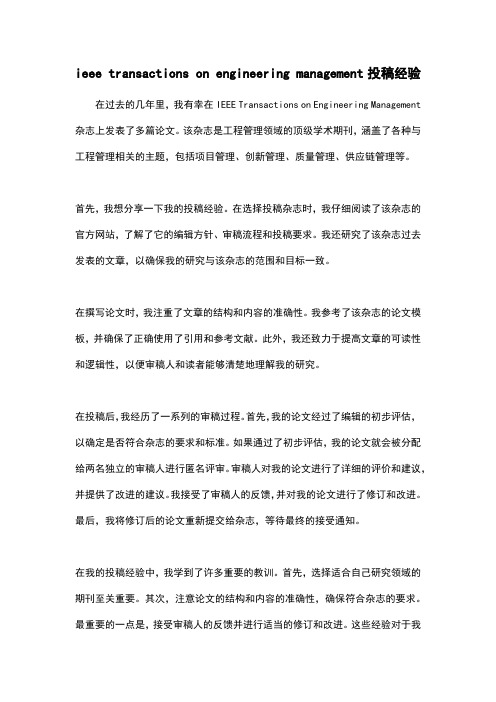
ieee transactions on engineering management投稿经验在过去的几年里,我有幸在IEEE Transactions on Engineering Management 杂志上发表了多篇论文。
该杂志是工程管理领域的顶级学术期刊,涵盖了各种与工程管理相关的主题,包括项目管理、创新管理、质量管理、供应链管理等。
首先,我想分享一下我的投稿经验。
在选择投稿杂志时,我仔细阅读了该杂志的官方网站,了解了它的编辑方针、审稿流程和投稿要求。
我还研究了该杂志过去发表的文章,以确保我的研究与该杂志的范围和目标一致。
在撰写论文时,我注重了文章的结构和内容的准确性。
我参考了该杂志的论文模板,并确保了正确使用了引用和参考文献。
此外,我还致力于提高文章的可读性和逻辑性,以便审稿人和读者能够清楚地理解我的研究。
在投稿后,我经历了一系列的审稿过程。
首先,我的论文经过了编辑的初步评估,以确定是否符合杂志的要求和标准。
如果通过了初步评估,我的论文就会被分配给两名独立的审稿人进行匿名评审。
审稿人对我的论文进行了详细的评价和建议,并提供了改进的建议。
我接受了审稿人的反馈,并对我的论文进行了修订和改进。
最后,我将修订后的论文重新提交给杂志,等待最终的接受通知。
在我的投稿经验中,我学到了许多重要的教训。
首先,选择适合自己研究领域的期刊至关重要。
其次,注意论文的结构和内容的准确性,确保符合杂志的要求。
最重要的一点是,接受审稿人的反馈并进行适当的修订和改进。
这些经验对于我以后的投稿和学术研究都非常有帮助。
总的来说,IEEE Transactions on Engineering Management是一个非常有声誉的期刊,它为工程管理领域的学者和从业者提供了一个重要的交流平台。
通过我的投稿经验,我深刻体会到了这个期刊的严谨性和学术水准。
我相信,在这个期刊上发表论文对于我的学术发展和学术声誉都有着积极的影响。
ieee会议论文从手稿到发表
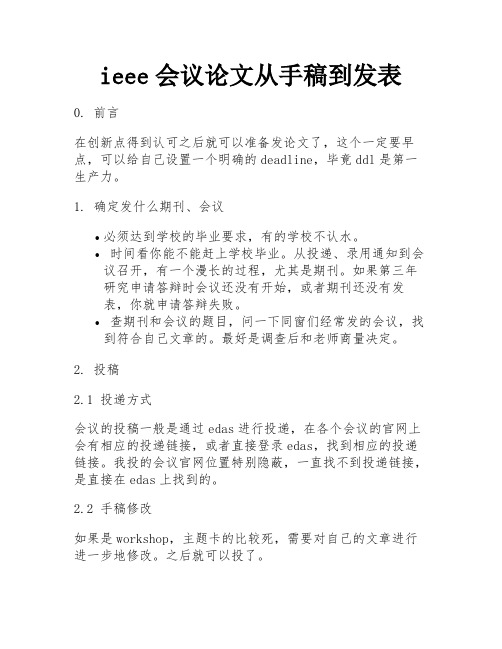
ieee会议论文从手稿到发表0. 前言在创新点得到认可之后就可以准备发论文了,这个一定要早点,可以给自己设置一个明确的deadline,毕竟ddl是第一生产力。
1. 确定发什么期刊、会议•必须达到学校的毕业要求,有的学校不认水。
•时间看你能不能赶上学校毕业。
从投递、录用通知到会议召开,有一个漫长的过程,尤其是期刊。
如果第三年研究申请答辩时会议还没有开始,或者期刊还没有发表,你就申请答辩失败。
•查期刊和会议的题目,问一下同窗们经常发的会议,找到符合自己文章的。
最好是调查后和老师商量决定。
2. 投稿2.1 投递方式会议的投稿一般是通过edas进行投递,在各个会议的官网上会有相应的投递链接,或者直接登录edas,找到相应的投递链接。
我投的会议官网位置特别隐蔽,一直找不到投递链接,是直接在edas上找到的。
2.2 手稿修改如果是workshop,主题卡的比较死,需要对自己的文章进行进一步地修改。
之后就可以投了。
2.3 整理格式2.3.1 模板下载以及使用ieee论文有它自己的模板,可以访问IEEE官网获取模板,我是使用的会议latex模板,之后的介绍也是基于latex的。
下载下来之后如下图所示。
latex几乎不用学,需要用到什么时直接搜索相应的技术帖即可。
我是在overleaf网站上在线编译的。
新建一个项目,将下载下来的论文模板上传到项目中,找到.tex格式的文件,使用overleaf打开,工作台有两栏,一个是源码,另一个是编译之后的pdf文档。
可以对照文档中的内容简单熟悉一下latex语法。
之后将自己的手稿填充上去即可,比较麻烦的是图片、公式和引用,后边一一介绍。
2.3.2 高质量图片、矢量图生成IEEE会要求高质量的图片,最好是矢量图。
我涉及到的图片格式有使用visio、drawio绘图完成后导出的pdf格式矢量图,以及Python绘制的jpg格式的仿真图。
visiovisio支持一些基本的图标、图形、线条等,但还有一些专业的图标,都是矢量图。
IEEE投稿指南
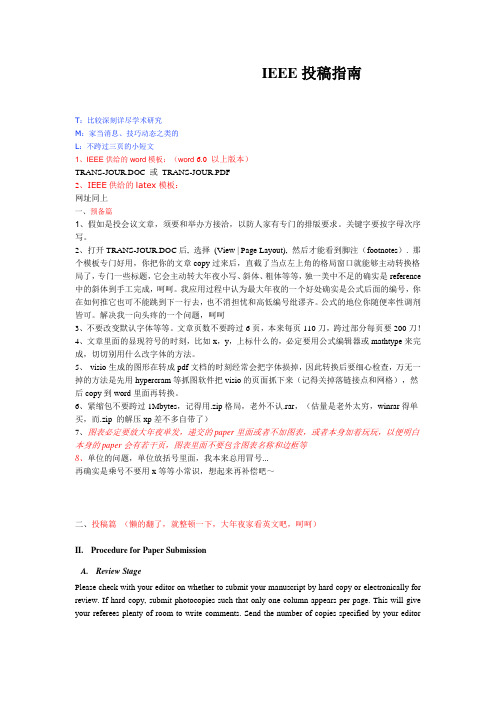
IEEE投稿指南T:比较深刻详尽学术研究M:家当消息、技巧动态之类的L:不跨过三页的小短文1、IEEE供给的word模板:(word 6.0 以上版本)TRANS-JOUR.DOC 或TRANS-JOUR.PDF2、IEEE供给的latex模板:网址同上一、预备篇1、假如是投会议文章,须要和举办方接洽,以防人家有专门的排版要求。
关键字要按字母次序写。
2、打开TRANS-JOUR.DOC后, 选择(View | Page Layout), 然后才能看到脚注(footnotes). 那个模板专门好用,你把你的文章copy过来后,直截了当点左上角的格局窗口就能够主动转换格局了,专门一些标题,它会主动转大年夜小写、斜体、粗体等等,独一美中不足的确实是reference 中的斜体到手工完成,呵呵。
我应用过程中认为最大年夜的一个好处确实是公式后面的编号,你在如何推它也可不能跳到下一行去,也不消担忧和高低编号纰谬齐。
公式的地位你随便率性调剂皆可。
解决我一向头疼的一个问题,呵呵3、不要改变默认字体等等。
文章页数不要跨过6页,本来每页110刀,跨过部分每页要200刀!4、文章里面的显现符号的时刻,比如x,y,上标什么的,必定要用公式编辑器或mathtype来完成,切切别用什么改字体的方法。
5、visio生成的图形在转成pdf文档的时刻经常会把字体损掉,因此转换后要细心检查,万无一掉的方法是先用hypercram等抓图软件把visio的页面抓下来(记得关掉落链接点和网格),然后copy到word里面再转换。
6、紧缩包不要跨过1Mbytes,记得用.zip格局,老外不认.rar,(估量是老外太穷,winrar得单买,而.zip 的解压xp差不多自带了)7、图表必定要放大年夜单发,递交的paper里面或者不加图表,或者本身加着玩玩,以便明白本身的paper会有若干页,图表里面不要包含图表名称和边框等8、单位的问题,单位放括号里面,我本来总用冒号...再确实是乘号不要用x等等小常识,想起来再补偿吧~二、投稿篇(懒的翻了,就整顿一下,大年夜家看英文吧,呵呵)II.Procedure for Paper SubmissionA.Review StagePlease check with your editor on whether to submit your manuscript by hard copy or electronically for review. If hard copy, submit photocopies such that only one column appears per page. This will give your referees plenty of room to write comments. Send the number of copies specified by your editor(typically four). If submitted electronically, find out if your editor prefers submissions on disk or as e-mail attachments.If you want to submit your file with one column electronically, please do the following:--First, click on the View menu and choose Print Layout.--Second, place your cursor in the first paragraph. Go to the Format menu, choose Columns, choose one column Layout, and choose “apply to whole document” from the dropdown menu.--Third, click and drag the right margin bar to just over 4 inches in width.The graphics will stay in the “second” column, but you can drag them to the first column. Make the graphic wider to push out any text that may try to fill in next to the graphic.B.Final StageWhen you submit your final version, after your paper has been accepted, print it in two-column format, including figures and tables. Send three prints of the paper; two will go to IEEE and one will be retained by the Editor-in-Chief or conference publications chair.You must also send your final manuscript on a disk, which IEEE will use to prepare your paper for publication. Write the authors’ names on the disk label. If you are using a Macintosh, please save your file on a PC formatted disk, if possible. You may use Zip or CD-ROM disks for large files, or compress files using Compress, Pkzip, Stuffit, or Gzip.Also send a sheet of paper with complete contact information for all authors. Include full mailing addresses, telephone numbers, fax numbers, and e-mail addresses. This information will be used to send each author a complimentary copy of the journal in which the paper appears. In addition, designate one author as the “corresponding author.” This is the author to whom proofs of the paper will be sent. Proofs are sent to the corresponding author only.C.Figures (这段专门重要,确实是说图表必定要放大年夜单发,递交的paper里面或者不加图表,或者本身加着玩玩,以便明白本身的paper会有若干页)All tables and figures will be processed as images. However, IEEE cannot extract the tables and figures embedded in your document. (The figures and tables you insert in your document are only to help you gauge the size of your paper, for the convenience of the referees, and to make it easy for you to distribute preprints.) Therefore, submit, on separate sheets of paper, enlarged versions of the tables and figures that appear in your document. These are the images IEEE will scan and publish with your paper.D.Electronic Image Files (Optional)You will have the greatest control over the appearance of your figures if you are able to prepare electronic image files. If you do not have the required computer skills, just submit paper prints as described above and skip this section.1) Easiest Way: If you have a scanner, the best and quickest way to prepare noncolor figure files is to print your tables and figures on paper exactly as you want them to appear, scan them, and then save them to a file in PostScript (PS) or Encapsulated PostScript (EPS) formats. Use a separate file for each image. File names should be of the form “fig1.ps” or “fig2.eps.”2) Slightly Harder Way: Using a scanner as above, save the images in TIFF format. High-contrast line figures and tables should be prepared with 600 dpi resolution and saved with no compression, 1 bit per pixel (monochrome), with file names of the form “fig3.tif” or “table1.tif.” To obtain a 3.45-in figure (one-column width) at 600 dpi, the figure requires a horizontal size of 2070 pixels. Typical file sizes will be on the order of 0.5 MB.Photographs and grayscale figures should be prepared with 220 dpi resolution and saved with no compression, 8 bits per pixel (grayscale). To obtain a 3.45-in figure (one-column width) at 220 dpi, the figure should have a horizontal size of 759 pixels.Color figures should be prepared with 400 dpi resolution and saved with no compression, 8 bits per pixel (palette or 256 color). To obtain a 3.45-in figure (one column width) at 400 dpi, the figure should have a horizontal size of 1380 pixels.4) Other Ways: Experienced computer users can convert figures and tables from their original format to TIFF. Some useful image converters are Adobe Photoshop, Corel Draw, and Microsoft Photo Editor, an application that is part of Microsoft Office 97 and Office 2000 (look for C:\Program Files\Common Files \Microsoft Shared\ PhotoEd\ PHOTOED.EXE. (You may have to custom-install Photo Editor from your original Office disk.)Here is a way to make TIFF image files of tables. First, create your table in Word. Use horizontal lines but no vertical lines. Hide gridlines (Table | Hide Gridlines). Spell check the table to remove any red underlines that indicate spelling errors. Adjust magnification (View | Zoom) such that you can view the entire table at maximum area when you select View | Full Screen. Move the cursor so that it is out of the way. Press “Print Screen” o n your keyboard; this copies the screen image to the Windows clipboard. Open Microsoft Photo Editor and click Edit | Paste as New Image. Crop the table image (click Select button; select the part you want, then Image | Crop). Adjust the properties of the image (File | Properties) to monochrome (1 bit) and 600 pixels per inch. Resize the image (Image | Resize) to a width of 3.45 inches. Save the file (File | Save As) in TIFF with no compression (click “More” button). Most graphing programs allow you to save graphs in TIFF; however, you often have no control over compression or number of bits per pixel. You should open these image files in a program such as Microsoft Photo Editor and re-save them using no compression, either 1 or 8 bits, and either 600 or 220 dpi resolution (File | Properties; Image | Resize). See Section II-D2 for an explanation of number of bits and resolution. If your graphing program cannot export to TIFF, you can use the same technique described for tables in the previous paragraph.A way to convert a figure from Windows Metafile (WMF) to TIFF is to paste it into Microsoft PowerPoint,save it in JPG format, open it with Microsoft Photo Editor or similar converter, and re-save it as TIFF.Microsoft Excel allows you to save spreadsheet charts in Graphics Interchange Format (GIF). To get good resolution, make the Excel charts very large. Then use the “Save asNo matter how you convert your images, it is a good idea to print the TIFF files to make sure nothing was lost in the conversion.If you modify this document for use with other IEEE journals or conferences, you should save it as type “Word 97-2000 & 6.0/95 - RTF (*.doc)” so that it can be opened by any version of Word.E.Copyright FormIII.M ATHIV.UnitsUse either SI (MKS) or CGS as primary units. (SI units are strongly encouraged.) English units may be used as secondary units (in parentheses). This applies to papers in data storage. For example, write “15 Gb/cm2 (100 Gb/in2).” An exception is when English units are used as identifiers in trade, such as“3½ in disk drive.” Avoid combining SI and CGS units, such as current in amperes and magnetic field in oersteds. This often leads to confusion because equations do not balance dimensionally. If you must use mixed units, clearly state the units for each quantity in an equation.The SI unit for magnetic field strength H is A/m. However, if you wish to use units of T, either refer to magnetic flux density B or magnetic field strength symbolized as µ0H. Use the center dot to separate compound units, e.g., “A·m2.”V.Helpful HintsA.Figures and TablesBecause IEEE will do the final formatting of your paper, you do not need to position figures and tables at the top and bottom of each column. In fact, all figures, figure captions, and tables can be at the end of the paper. Large figures and tables may span both columns. Place figure captions below the figures; place table titles above the tables. If your figure has two parts, include the labels “(a)” and “(b)” as part of the artwork. Please verify that the figures and tables you mention in the text actually exist. Please do not include captions as part of the figures. Do not put captions in “text boxes” linked to the figures. Do not put borders around the outside of your figures. Use the abbreviation “Fig.” even at the beginning of a sentence. Do not abbreviate “Table.” Tables are numbered with Roman numerals. Color printing of figures is available, but is billed to the authors (approximately $1300, depending on the number of figures and number of pages containing color). Include a note with your final paper indicating that you request color printing. Do not use color unless it is necessary for the proper interpretation of your figures. If you want reprints of your color article, the reprint order should be submitted promptly. There is an additional charge of $81 per 100 for color reprints.Figure axis labels are often a source of confusion. Use words rather than symbols. As an example, write the quantity “Magnetization,” or “Mag netization M,” not just “M.” Put units in parentheses. Do not label axes only with units. As in Fig. 1, for example, write “Magnetization (A/m)” or “Magnetization (A m-1),” not just “A/m.” Do not label axes with a ratio of quantities and units. For example, write “Temperature (K),” not “Temperature/K.”Multipliers can be especially confusing. Write “Magnetization (kA/m)” or “Magnetization (103A/m).” Do not write “Magnetization (A/m) ´1000” because the reader would not know whether the top axis label in Fig. 1 meant 16000 A/m or 0.016 A/m. Figure labels should be legible, approximately 8 to 12 point type.B.ReferencesNumber citations consecutively in square brackets [1]. The sentence punctuation follows the brackets [2]. Multiple references [2], [3] are each numbered with separate brackets [1]–[3]. When citing a section in a book, please give the relevant page numbers [2]. In sentences, refer simply to the reference number, as in [3]. Do not use “Ref. [3]” or “reference [3]” except at the beginning of a sentence: “Reference [3] shows ... .” Unfortunately the IEEE document translator cannot handle automatic endnotes in Word; therefore, type the reference list at the end of the paper using the “References” style. Please note that the references at the end of this document are in the preferred referencing style. Give all authors’ names; do not use “et al.” unless there are six authors or more. Use a space after authors' initials. Papers that have not been published should be cited as “unpublished” [4]. Pap ers that have been submitted for publication should be cited as “submitted for publication” [5]. Papers that have beenaccepted for publication, but not yet specified for an issue should be cited as “to be published” [6]. Please give affiliations and addresses for private communications [7].Capitalize only the first word in a paper title, except for proper nouns and element symbols. For papers published in translation journals, please give the English citation first, followed by the original foreign-language citation [8].C.Abbreviations and AcronymsDefine abbreviations and acronyms the first time they are used in the text, even after they have already been defined in the abstract. Abbreviations such as IEEE, SI, ac, and dc do not have to be defined. Abbreviations that incorporate periods should not have spaces: write “C.N.R.S.,” not “C. N. R. S.” Do not use abbreviations in the title unless they are unavoidable (for example, “IEEE” in the title of this article).D.EquationsNumber equations consecutively with equation numbers in parentheses flush with the right margin, as in (1). First use the equation editor to create the equation. Then select the “Equation” markup style. Press the tab key and write the equation number in parentheses. To make your equations more compact, you may use the solidus ( / ), the exp function, or appropriate exponents. Use parentheses to avoid ambiguities in denominators. Punctuate equations when they are part of a sentence, as in(1)Be sure that the symbols in your equation have been defined before the equation appears or immediately following. Italicize symbols (T might refer to temperature, but T is the unit tesla). Refer to “(1),” not “Eq. (1)” or “equation (1),” except at the beginning of a sentence: “Equation(1) is ... .”E.Other RecommendationsUse one space after periods and colons. Hyphenate complex modifiers: “zero-field-cooled magnetization.” Avoid dangling participles, such as, “Using (1), the potential was calculated.” [It is not clear who or what used (1).] Write instead, “The potential was calculated by using (1),” or “Using (1), we calculated the potential.”Use a zero before decimal points: “0.25,” not “.25.” Use “cm3,” not “cc.” Indicate sample dimensions as “0.1 cm ´0.2 cm,” not “0.1 ´ 0.2 cm2.” The abbreviation for “seconds” is “s,” not “sec.” Do not mix complete spellings and abbreviations of units: use “Wb/m2” or “webers per square meter,” not “webers/m2.” When expressing a range of values, write “7 to 9” or “7-9,” not “7~9.”A parenthetical statement at the end of a sentence is punctuated outside of the closing parenthesis (like this). (A parenthetical sentence is punctuated within the parentheses.) In American English, periods and commas are within quotation marks, like “this period.” Other punctuation is “outside”! Avoid contractions; for example, write “do not” instead of “don’t.” The serial comma is preferred: “A, B, and C” instead of “A,B and C.”If you wish, you may write in the first person singular or plural and use the active voic e (“I observed that ...” or “We observed that ...” instead of “It was observed that ...”). Remember to check spelling. If your native language is not English, please get a native English-speaking colleague to proofread your paper.VI.Some Common MistakesThe word “data” is plural, not singular. The subscript for the permeability of vacuum µ0 is zero, not a lowercase letter “o.” The term for residual magnetization is “remanence”; the adjective is “remanent”; do not write “remnance” or “remnant.” Use the word “micrometer” instead of “micron.” A graph within a graph is an “inset,” not an “insert.” The word “alternatively” is preferred to the word “alternately” (unless you really mean something that alternates). Use the word “whereas” instead of “while” (unless you are referring to simultaneous events). Do not use the word “essentially” to mean “approximately” or “effectively.” Do not use the word “issue” as a euphemism for “problem.” When compositions are not specified, separate chemical symbols by en-dash es; for example, “NiMn” indicates the intermetallic compound Ni0.5Mn0.5whereas “Ni–Mn” indicates an alloy of some composition Ni x Mn1-x.Be aware of the different meanings of the homophones “affect” (usually a verb) and “effect” (usually a noun), “complement” and “compliment,” “discreet” and “discrete,” “principal” (e.g., “principal investigator”) and “principle” (e.g., “principle of measurement”). Do not confuse “imply” and “infer.” Prefixes such as “non,” “sub,” “micro,” “multi,” and “"ultra” are not ind ependent words; they should be joined to the words they modify, usually without a hyphen. There is no period after the “et” in the Latin abbreviation “et al.” (it is also italicized). The abbreviation “i.e.,” means “that is,” and the abbreviation “e.g.,” means “for example” (these abbreviations are not italicized).An excellent style manual and source of information for science writers is [9]. A general IEEE style guide, Information for Authors, is available at。
[转载]转发一篇ieee?transaction投稿经验
![[转载]转发一篇ieee?transaction投稿经验](https://img.taocdn.com/s3/m/80ca2e38cdbff121dd36a32d7375a417866fc1d8.png)
[转载]转发一篇ieee transaction投稿经验展开全文原文地址:转发一篇ieee transaction投稿经验作者:hushi发信人: win6 (), 信区: Paper标题: 中了篇IEEE Trans发信站: 水木社区 (Sun Oct 17 19:18:18 2010), 站内计算机,分布式计算方向:IEEE Transactions on Parallel and Distributed Systems4月投的,7月给major review。
9月初把rebuttal和revised version发过去,前几天就接受了。
分享点经验:1)ieee trans 要求全面,没有纰漏。
任何小的纰漏都会被审稿人攻击。
所以投之前要n易其稿,假设自己是最苛刻的审稿人,斟酌每一个可能被攻击的细节。
如果审稿人无法找出错误,那你成功的可能性就大增了。
2)引用(citation)多多益善!因为每一次引用prior works都减少被攻击的可能性。
所以引用不只是在introduction/related works里面。
尤其注意problem formulation(ormodel)里面你的每一个假设(assumption)都尽量加引用,以免被质疑。
3)introduction非常重要!其中,background力求老妪能懂,因为审稿人可能和你不是一个方向。
motivation要清楚的阐述你的论文的重要性,独特性和开创性,否则编辑会建议你投小会议去吧。
paper review/related works要求全面,太少太简单审稿人会有意见。
objective/contribution也要清楚的阐述你的论文的重要性,独特性和开创性。
4)在performance evaluation里你需要将你做的东西和prior works比较(除非你做的东西没有前作可以比较),否则会被审稿人质疑。
5)conclusion是个减少纰漏的好机会!在conclusion中你可以将你的工作中的缺陷当做future works来讨论,也可以讨论如何去掉你的problem formulation中不大现实的假设。
IEEE投稿经验
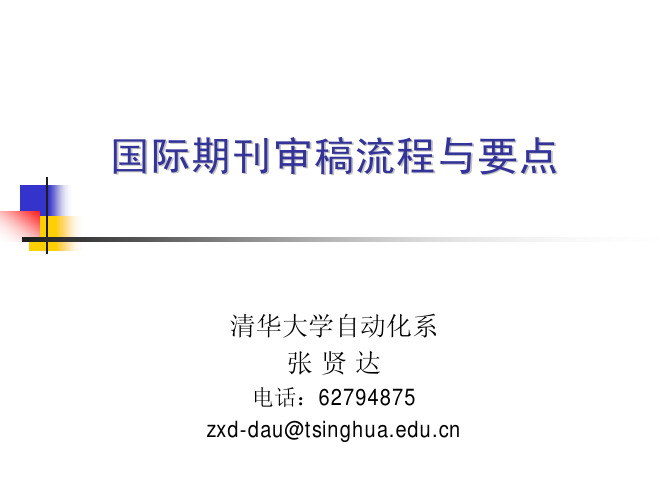
审稿要点(续)
II. RECOMMENDATION
( ) A Publish Unaltered ( ) AQ Publish in Minor, Required Changes (as noted in Section III) ( ) RQ Review Again After Major Changes (as noted in Section III) ( ) R Reject (Paper is not of sufficient quality or novelty to be published in this Transactions) ( ) R Reject (A major rewrite is required. Author should be encouraged to resubmit rewritten paper at some later time.) ( ) R Reject (Paper is seriously flawed; do not encourage resubmission.)
( ) Yes ( ) No
4. Are symbols, terms, and concepts adequately defined?
( ) Yes ( ) Not always ( ) No
审稿要点(续)
5. How do you rate the English usage?
( ) Satisfactory ( ) Needs improvement ( ) Poor
2. Are the title and abstract satisfactory?
( ) Yes ( ) No (explain: )
审稿要点(续)
ieee transactions on information theory投稿经验
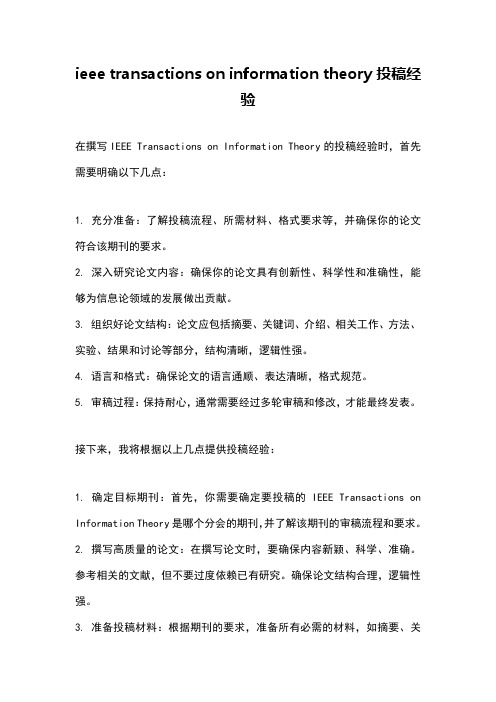
ieee transactions on information theory投稿经验在撰写IEEE Transactions on Information Theory的投稿经验时,首先需要明确以下几点:1. 充分准备:了解投稿流程、所需材料、格式要求等,并确保你的论文符合该期刊的要求。
2. 深入研究论文内容:确保你的论文具有创新性、科学性和准确性,能够为信息论领域的发展做出贡献。
3. 组织好论文结构:论文应包括摘要、关键词、介绍、相关工作、方法、实验、结果和讨论等部分,结构清晰,逻辑性强。
4. 语言和格式:确保论文的语言通顺、表达清晰,格式规范。
5. 审稿过程:保持耐心,通常需要经过多轮审稿和修改,才能最终发表。
接下来,我将根据以上几点提供投稿经验:1. 确定目标期刊:首先,你需要确定要投稿的IEEE Transactions on Information Theory是哪个分会的期刊,并了解该期刊的审稿流程和要求。
2. 撰写高质量的论文:在撰写论文时,要确保内容新颖、科学、准确。
参考相关的文献,但不要过度依赖已有研究。
确保论文结构合理,逻辑性强。
3. 准备投稿材料:根据期刊的要求,准备所有必需的材料,如摘要、关键词、介绍、相关工作、方法、实验、结果和讨论等部分的英文稿件,以及可能需要的其他证明文件。
4. 提交稿件:将稿件提交到指定的投稿系统或邮箱,并确保所有信息正确无误。
5. 等待审稿:提交稿件后,通常会收到审稿邀请。
耐心等待审稿过程,并按照审稿人的反馈进行修改和改进。
6. 修改和完善:根据审稿人的反馈,对论文进行修改和完善。
如果需要,可以向编辑或审稿人寻求帮助和指导。
7. 再次提交:修改完成后,再次提交稿件。
有时可能需要经过多轮审稿和修改才能最终发表。
8. 保持耐心和信心:整个过程可能需要一段时间,需要保持耐心。
同时,不要失去信心,即使最终未能发表,也可以从过程中学习到很多东西。
9. 跟进和联系:如果遇到任何问题或需要帮助,可以联系编辑或期刊工作人员。
ieee transactions on industrial informatics投稿经验
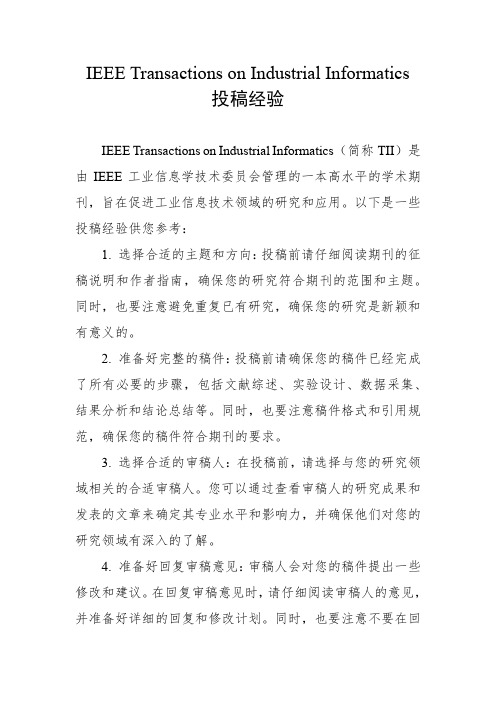
IEEE Transactions on Industrial Informatics投稿经验IEEE Transactions on Industrial Informatics(简称TII)是由IEEE工业信息学技术委员会管理的一本高水平的学术期刊,旨在促进工业信息技术领域的研究和应用。
以下是一些投稿经验供您参考:1. 选择合适的主题和方向:投稿前请仔细阅读期刊的征稿说明和作者指南,确保您的研究符合期刊的范围和主题。
同时,也要注意避免重复已有研究,确保您的研究是新颖和有意义的。
2. 准备好完整的稿件:投稿前请确保您的稿件已经完成了所有必要的步骤,包括文献综述、实验设计、数据采集、结果分析和结论总结等。
同时,也要注意稿件格式和引用规范,确保您的稿件符合期刊的要求。
3. 选择合适的审稿人:在投稿前,请选择与您的研究领域相关的合适审稿人。
您可以通过查看审稿人的研究成果和发表的文章来确定其专业水平和影响力,并确保他们对您的研究领域有深入的了解。
4. 准备好回复审稿意见:审稿人会对您的稿件提出一些修改和建议。
在回复审稿意见时,请仔细阅读审稿人的意见,并准备好详细的回复和修改计划。
同时,也要注意不要在回复中出现语法和拼写错误。
5. 接受或拒绝修改建议:如果您接受了审稿人的修改建议,请按照修改计划进行修改并重新提交稿件。
如果您不同意审稿人的意见,请准备好详细的反驳意见,并在回复中说明理由。
6. 等待最终决定:一旦您重新提交了稿件,就需要等待期刊编辑和审稿人的最终决定。
如果您的稿件被接受,您将收到正式的接受函和出版日期。
如果您的稿件被拒绝,您可以选择重新修改后再次投稿或考虑其他期刊。
总之,投稿前请仔细阅读期刊的征稿说明和作者指南,确保您的稿件符合期刊的要求和标准。
同时,也要注意与审稿人和编辑进行良好的沟通和合作,以提高您的稿件接受率。
- 1、下载文档前请自行甄别文档内容的完整性,平台不提供额外的编辑、内容补充、找答案等附加服务。
- 2、"仅部分预览"的文档,不可在线预览部分如存在完整性等问题,可反馈申请退款(可完整预览的文档不适用该条件!)。
- 3、如文档侵犯您的权益,请联系客服反馈,我们会尽快为您处理(人工客服工作时间:9:00-18:30)。
6. Rate the Bibliography.
( ) Satisfactory ( ) Unsatisfactory (explain: )
审稿要点(续)
D. Overall rating
1. How would you rate the technical contents of the paper?
( ) Yes ( ) No
4. Are symbols, terms, and concepts adequately defined?
( ) Yes ( ) Not always ( ) No
审稿要点(续)
5. How do you rate the English usage?
( ) Satisfactory ( ) Needs improvement ( ) Poor
2. Are the title and abstract satisfactory?
( ) Yes ( ) No (explain: )
审稿要点(续)
3. Is the length of the paper appropriate? If not, recommend how the length of the paper should be amended, including a possible target length for the final manuscript.
审稿要点(续)
3. How would you rate the literary presentation of the paper?
( ) Totally Accessible ( ) Mostly Accessible ( ) Partially Accessible ( ) Inaccessible
如何改进英文表述
在阅读英文文献的时候,认真将一些好的句型记下来,并 且加以分类(Introduction, Text, Simulations, Conclusion) 存储. 灵活调用有关句型.
例:
We summarize by itemizing what is new in this paper. The authors were motivated by two distinct engineering and physics applications. The author's original motivation for studying this problem came from a response to …
国际期刊审稿流程与要点
清华大学自动化系 张贤达
电话:62794875 zxd-dau@
目 录
国际期刊审稿流程 审稿要点 论文写作要点 论文修改要点 如何改进英文表述
国际期刊审稿流程
作者投稿(以电子投稿为例) Editor in Chief 或其办公室选择Associate Editor Associate Editor选择Reviewers Reviewers审稿 Associate Editor作决定
国际期刊审稿流程(续)
作者投送修改稿 Associate Editor组织第2次审稿 Reviewers审查作者对审稿意见的回答意见 Reviewers审查修改稿 Associate Editor作决定 发表 小修改后发表 Reject
审稿要点
I. REVIEW Please expand and give details in Section III. A. Suitability of topic 1. Is the topic appropriate for publication in these transactions?
审稿要点(续)
III. DETAILED COMMENTS
Please state why you rated the paper as you did in Sections I and II. If you have indicated that revisions are required, please give the author specific guidance regarding those revisions, differentiating between optional and mandatory changes.
论文写作要点
引言是吸引审稿人眼球的关键部分. 引言的写作要点: 本文所涉及的研究对象和领域的重要性 体现选题的重要性以及作者文献综述,总结的能力 总结本文的主要贡献与创新点
Reviewer又称 Referee,不要指望审稿人替你总结你的论文的主 要贡献和创新.审稿人的责任是裁判你所总结的本文主要贡献和 创新点(original contribution, fill in some gap, extension, generalization, important improvement)是否属 实,是否有价值?
4. How would you rate the appropriateness of this paper for publication in this IEEE Transactions?
( ) Excellent Match ( ) Good Match ( ) Weak Match ( ) Poor Match
( ) Yes ( ) Perhaps ( ) No
2. Is the topic important to colleagues working in the field?
( ) Yes ( ) Moderately So ( ) No (explain: )
审稿要点(续)
B. Content
1. Is the paper technically sound?
论文写作要点(续1)
正文的写作要点:
物理问题数学化,数学结果物理化.
数学化可避免单纯就事论事,使你的研究问题具有更加广泛的代表性.数学结 果的物理解释或涵义可以突出该结果的重要性和可信性,具有启迪的作用.
引用他人的结果,结论或观点,一定要注明. 本文主要贡献与创新点的论述
1.千万不要遗漏引用提出重要或者典型理论,方法的有关文献.否则,将会被 锯! 2. 阐明你有关理论,方法的idea! 3. 与现有主要理论或方法的比较 (有比较,才有鉴别):理论和实验比较.
( ) Excellent ( ) Good ( ) Fair ( ) Poor
2. How would you rate the novelty of the paper?
( ) Highly Novel ( ) Not Novel ( ) Sufficiently Novel ( ) Slightly Novel
审稿要点(续)
II. RECOMMENDATION
( ) A Publish Unaltered ( ) AQ Publish in Minor, Required Changes (as noted in Section III) ( ) RQ Review Again After Major Changes (as noted in Section III) ( ) R Reject (Paper is not of sufficient quality or novelty to be published in this Transactions) ( ) R Reject (A major rewrite is required. Author should be encouraged to resubmit rewritten paper at some later time.) ( ) R Reject (Paper is seriously flawed; do not encourage resubmission.)
论文写作要点(续4)
结论的写作要点
总结本文的主要贡献与创新,与引言相呼应.
论文采用的标准:
有创新. 高质量. 质量低的创新(与现有理论/方法相比较,无明显效果和意 义)通常不会被录用.
论文修改要点
认真按照审稿人的意见修改. 写一个Response to Reviewers' Comments, 详细 说明你是如何按照审稿人意见进行修改的(别忘 了感谢Associate Editor和Reviewers的Comments and Suggestions,千万不要与审稿人辩论). 回答不了的问题可以作为待研究的问题在结论中 提出.
( ) Yes ( ) No (why not? )</P>
2. Is the coverage of the topic sufficiently comprehensive and balanced?
( ) Yes ( ) Important information is missing or superficially treated. ( ) Treatment somewhat unbalanced, but not seriously so. ( ) Certain parts significantly overstresses.
4. How would you rate the technical novelty of the paper?
( ) Novel ( ) Somewhat Novel ( ) Not Novel
审稿要点(续)
C. Presentation
1. How would you rate the overall organization of the paper? ( ) Satisfactory ( ) Could be improved ( ) Poor
The remainder of this paper is organized as follows. We now outline this paper.
